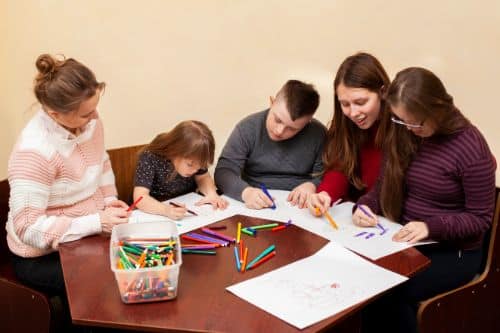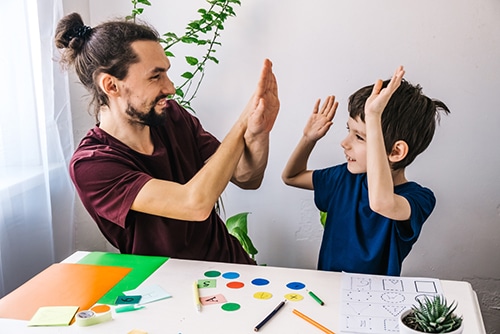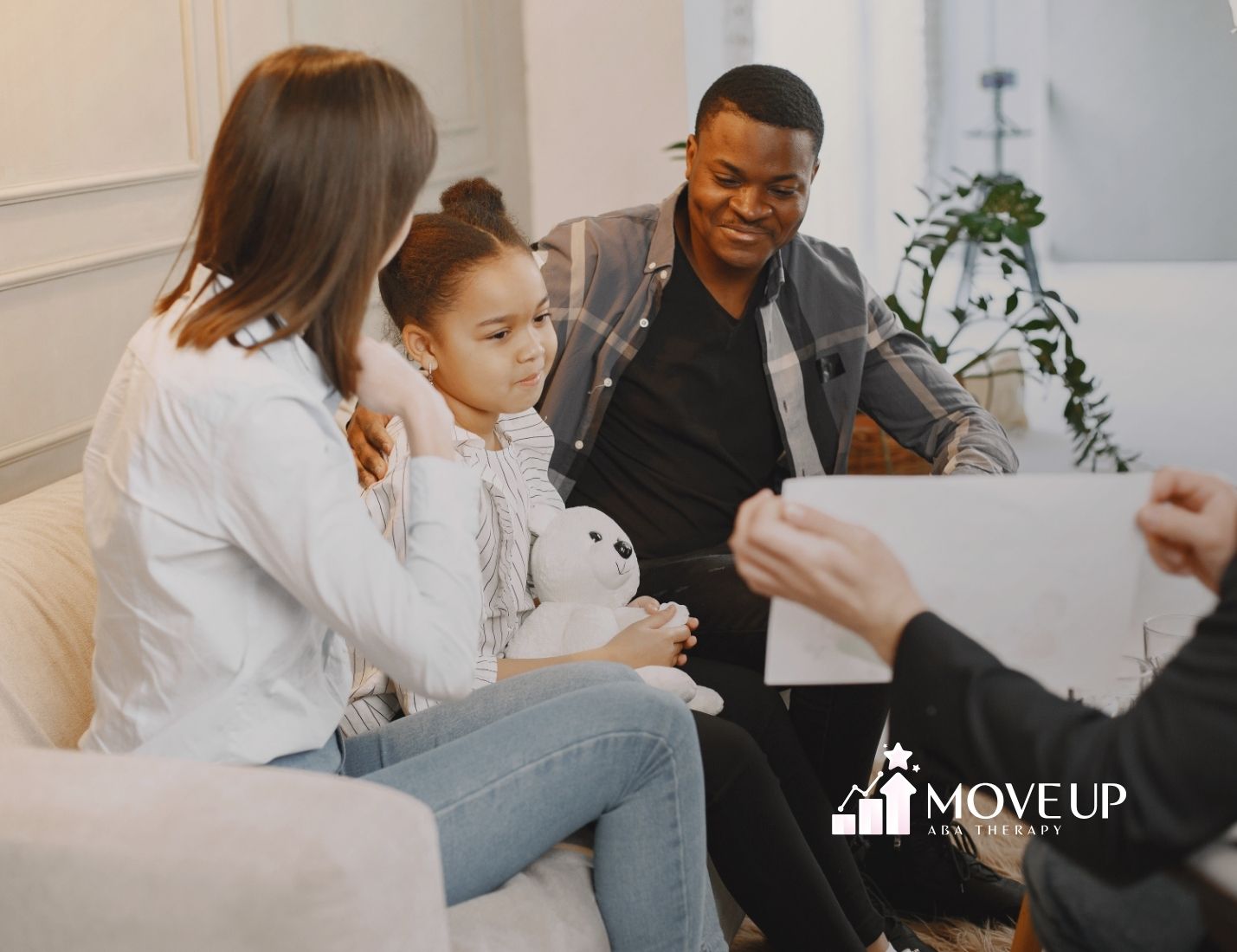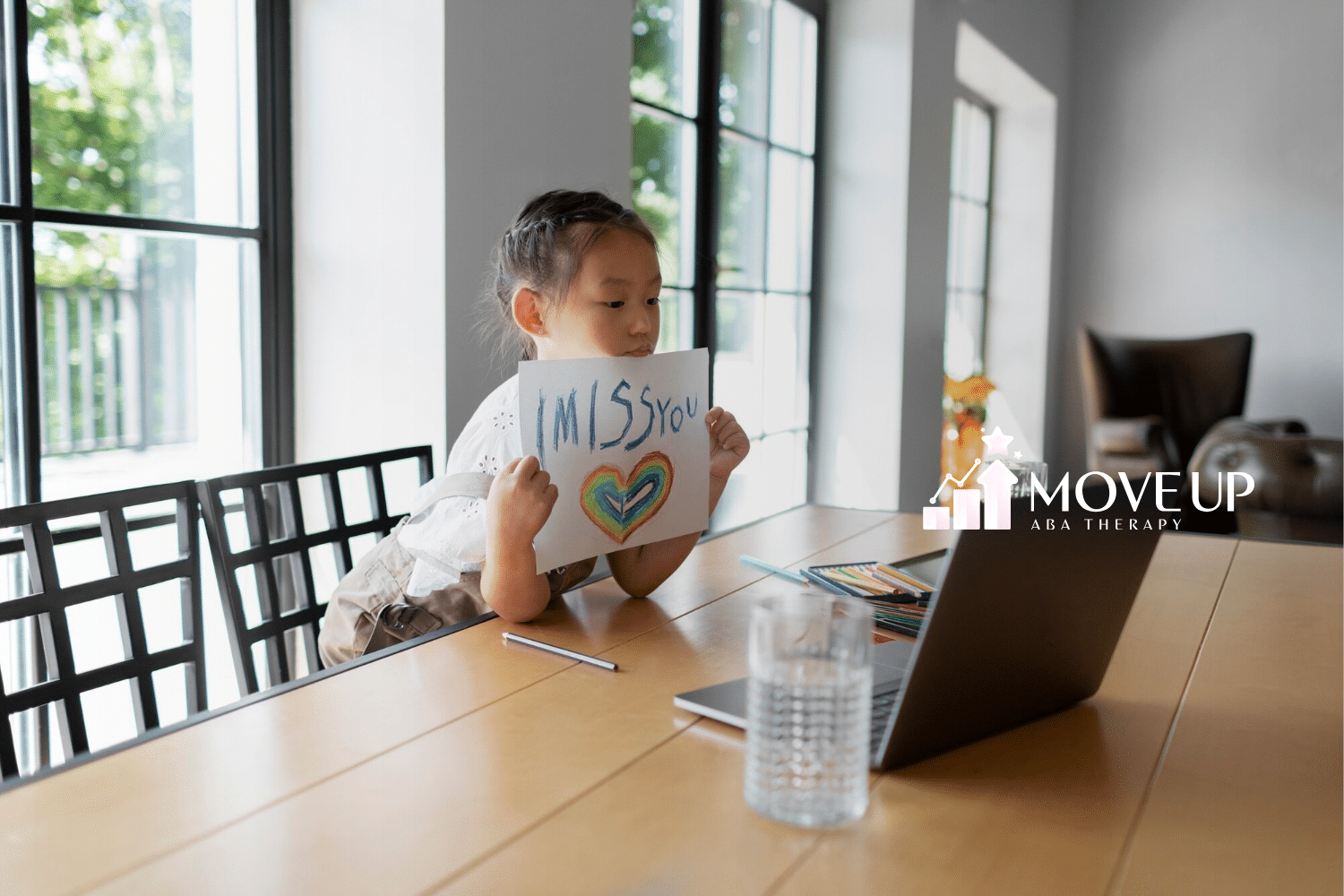How to Prepare Home for In-Home ABA Therapy? It’s crucial to understand how to set up your home for these sessions. This way you can establish an accommodating atmosphere that supports the therapy process. In home ABA therapy, which is also referred to as Applied Behavior Analysis is an beneficial intervention, for kids diagnosed with ASD (Autism Spectrum Disorder.
Therapy sessions can take place in the child’s home creating an comforting environment. This helps stress and anxiety often linked to surroundings while also allowing therapy to happen in a more authentic setting.
By following these essential tips, you can help create an optimal environment for your child’s therapy and ensure the success of their in-home ABA therapy sessions.
Success Stories
“Move Up ABA has been a lifeline for our family. Before starting therapy, our son struggled with daily routines and communication. Now, he’s more independent and even initiated a conversation with a classmate for the first time! The progress we’ve seen in just six months is truly remarkable.”
- Emily R., Silver Spring, Accountant
“As a single dad, I was overwhelmed trying to manage my child’s behavior. The Move Up ABA team not only provided amazing support for my little girl but also taught me practical strategies to use at home. Their in-home sessions fit perfectly with our busy schedule. I’m so grateful for their patience and expertise.”
- Michael T., Rockville, Middle School Teacher
“We were hesitant about starting ABA therapy, but Move Up ABA’s approach put us at ease from day one. Our twins have made incredible strides in their social skills and self-regulation. The therapists are like extended family now, and we couldn’t be happier with our decision to work with them.”
- Aisha and James L., Simpson, Police Officers
Ready to start your child's journey to success? Schedule a free consultation today! 📞 Call (410) 497-8865.
How do I start therapy at home?
To begin doing therapy at home for ABA therapy set up an area, for therapy with distractions gather the materials recommended by the therapist create a schedule for therapy sessions and maintain clear communication, with the therapist to coordinate on objectives and monitoring progress.
1. Designate a Dedicated Therapy Space
Start by setting up a dedicated area for therapy. This should be a quiet, distraction-free zone that promotes focus and learning. Establishing a boundary between therapy sessions and other daily routines at home is essential. The space should allow your child to engage in therapy comfortably, with the supervision requirements for RBT being closely adhered to, ensuring the proper guidance during therapy tasks.
When you assign a spot, for therapy you establish a boundary between therapy sessions and other daily routines at home. When selecting the therapy area take into account the surroundings. For instance, if your child loves being outside you might want to think about arranging therapy sessions on a porch or, in the garden.

The objective is to set up an area where your child can participate in therapy exercises comfortably and calmly. Clearing away any mess or objects that could lead to disruptions, during sessions can also contribute to establishing a concentrated and effective therapy setting.
2. Organize Therapy Materials and Toys
How to Prepare Home for In-Home ABA Therapy sessions involves a step of arranging therapy materials and toys. These resources are essential, for facilitating your childs learning and encouraging behaviors. By organizing them in an accessible way you can help ensure that therapy sessions are productive and well structured.
Tag therapy tools and toys by their intended use and the skills they target. This will simplify the process of finding and utilizing items for both you and the therapist during therapy sessions. Also remember to have your childs toys in the therapy space. Having toys that your child loves can boost their interest and participation, in therapy sessions.
Make sure to check and refresh the therapy items and toys regularly to keep them interesting and captivating for your child. Bringing in materials and toys from time, to time can help sustain your childs attention and improve their learning journey during therapy sessions.
3. Ensure a Comfortable Seating Arrangement
How to Prepare Home for In-Home ABA Therapy for enhancing an effective session? The seating layout needs to be comfy and encouraging enabling your child to concentrate and participate in therapy tasks without any discomfort or interruptions.
When setting up for therapy sessions it’s an idea to use furniture that fits your childs age and size. This can make your child feel more at ease and comfortable. Also make sure the seating arrangement promotes interaction, between your child and the therapist. You could arrange chairs or seating areas so they face each other encouraging eye contact and communication.
4. Minimize Distractions in the Therapy Area
Creating the learning atmosphere during, at home ABA therapy sessions requires minimizing any disruptions, in the therapy space. Distractions can interfere with your childs concentration and ability to participate fully in therapy tasks.
During therapy sessions make sure to eliminate any distractions that could divert your childs focus. This means removing gadgets, TVs or anything else that might cause auditory interruptions. Keep the therapy space tidy and well organized to prevent clutter and promote an concentrated atmosphere.
Make sure the therapy area is free, from any noises or disruptions, like traffic or household commotion. This way you can establish an serene environment for your child to focus on therapy exercises and tasks. By reducing distractions you’re setting up a learning atmosphere that encourages concentration and advancement in your child’s therapy sessions.
5. Create a Visual Schedule
Designing a timetable proves to be a method, in ensuring a sense of order and consistency for ABA therapy sessions conducted at home. By incorporating aids, like schedules, timers and image cards you can assist your child in grasping and adhering to the therapy routine thereby easing stress levels and improving their communication and comprehension abilities.
Create a timetable illustrating the order of therapy tasks and rest periods. You can achieve this using a whiteboard, poster board or a digital visual scheduler application. Incorporate visual. Tags to depict each task and break aiding your child in comprehending and predicting the events.
Make sure to go over the schedule with your child at the start of every therapy session to help them better grasp and get involved. Let your child participate in making and updating the schedule so they can be more engaged. Feel a sense of responsibility, for their therapy routine.
6. Set Up Safety Measures and Accessibility
Ensuring safety measures and accessibility is essential when establishing an environment for, in home ABA therapy. It is important to recognize and deal with any dangers or safety issues in the therapy space. It is also important to ensure that the therapist you choose is certified and has achieved a passing score for the RBT exam for the best results.
Make sure to set up gates or barriers to block off parts of your house where your child could get into trouble. This includes stairs, balconies and rooms, with unsafe objects. Also fasten down furniture and electronics to stop them from tipping over or falling.
Regularly inspect the therapy area for any potential hazards, such as loose cords, sharp objects, or slippery surfaces, and address them promptly. Ensure that the therapy space is easily accessible for both your child and the therapist, considering any mobility or sensory needs.
By putting safety protocols in place and making sure everything is easily accessible you establish an caring setting where your child can concentrate on therapy tasks and enhance their happiness.
7. Incorporate Sensory-Friendly Lighting and Decor
Enhancing the therapy setting for children, with autism spectrum disorder (ASD) by incorporating sensory lighting and decorations can significantly improve their experience. It is important to consider the sensitivities of individuals with ASD as these can impact their comfort and active engagement, in therapy sessions.
Try using lighting or sunlight to establish an relaxing ambiance, in the therapy space. Stay away, from fluorescent lights that could lead to unease or sensory overwhelm. Additionally you might want to consider using dimmer switches or lampshades to control the brightness of the light.
Opt for decorations and furniture that’re cozy and soothing for your child. Consider items, like bean bags, cushions or plush rugs to offer a tactile experience and create an atmosphere. Steer clear of visually busy decorations that could potentially disrupt or overstimulate your child.
By setting up a space that’s sensory friendly you can make your child feel at ease and involved during therapy sessions enabling them to concentrate on learning and developing skills.
8. Establish Clear Boundaries and Rules
Setting boundaries and guidelines is crucial, for building an respectful ABA therapy setting at home. By establishing expectations and rules, your child can grasp the behaviors and encourage positive engagement in therapy sessions. This allows you to practice different ABA therapy techniques better as well.
- Communicate expectations for behavior during therapy sessions, such as respecting personal space, following directions, and using appropriate language.
- Encourage behavior by giving praise and rewards.
- Make sure there are outcomes for behaviors that’re difficult, like taking away privileges or giving time outs.
- Create a visual chart or checklist to help your child track their progress and accomplishments during therapy sessions.
- Involve your child in establishing rules and boundaries, allowing them to have input and ownership in the therapeutic process.
When you set limits and guidelines you build an courteous atmosphere that encourages education, teamwork and good conduct, in ABA therapy sessions conducted at home.
9. Prepare a Reinforcement Inventory

Preparing a reinforcement inventory is an important step in creating a motivating and rewarding in-home ABA therapy environment. Reinforcement is a key component of ABA therapy as it helps to motivate and reinforce desired behaviors.
- Identify a variety of reinforcements that are meaningful and motivating for your child. This can include stickers, toys, preferred activities, or verbal praise.
- Create a system for delivering reinforcement during therapy sessions, such as a token economy system or a reward chart.
- Make sure to have types of support materials, on hand in the therapy space making sure they are easy to reach and suitable, for the persons age.
- Rotate reinforcements periodically to maintain their effectiveness and prevent boredom.
- Collaborate closely with your ABA therapist to create reinforcement plans that match your child’s requirements and objectives.
When you put together a collection of rewards you’re setting up an engaging atmosphere that motivates your child to take a role and make progress, in therapy sessions.
10. Discuss the Therapy Plan with Family Members
Effective communication and engaging with family members play a role in the effectiveness of providing ABA therapy at home. It’s essential to have conversations, about the therapy plan with family members to ensure everyone is aligned and able to offer support, for your child.
- Make sure to communicate the therapy objectives, approaches and hopes with your family members making sure they grasp the reasons and significance of therapy.
- Encourage your family members to join therapy sessions and get involved so they can pick up ABA techniques and strategies to help your child’s progress beyond the therapy sessions.
- Keep the channels of communication, with your family members. Motivate them to express their thoughts, worries or ideas about the treatment strategy.
- Regularly update and involve family members in the progress and achievements of your child’s therapy.
- Foster a collaborative and supportive environment where family members can actively contribute to the therapy journey.
Engage in conversations, with your family about the treatment plan to establish a support system that boosts the impact of ABA therapy, at home and fosters your child’s growth.
11. Integrate Preferred Activities into Sessions
Incorporating activities that your child loves and finds motivating into How to Prepare Home for In-Home ABA Therapy sessions at home can greatly boost engagement and foster skill growth. Preferred activities, such, as toys or interests can enhance your child’s motivation during therapy sessions making them more fun and fulfilling.
Discover what your child enjoys doing and use those activities to make therapy sessions more engaging. This could involve playing with toys exploring experiences or taking part in favorite hobbies.
By incorporating activities that your child enjoys you can make the most of their interests. Offer fulfilling experiences that encourage involvement, skill enhancement and advancement, in therapy.
12. Use Technology and Apps Supportively
Integrating technology and apps in a way during ABA therapy sessions, at home can significantly improve the learning process. Use apps specifically created for behavior analysis. Enhancing skills to complement approaches. Engaging games and educational apps customized to your child’s requirements can enhance the learning experience.
Using technology can offer assistance help monitor progress and introduce methods to encourage positive behaviors. By incorporating these resources you can establish a vibrant and efficient therapy setting tailored to your child’s needs.
13. Regularly Update the Therapy Space
How to Prepare Home for In-Home ABA Therapy environment lively and engaging it’s important to update the therapy space. This helps keep things interesting prevents boredom and ultimately improves the quality of therapy sessions. Adding elements moving furniture around or changing up the toys can help maintain interest and meet changing needs effectively.
Keeping the therapy space updated with a fresh environment fosters skill enhancement. Promotes positive behavior. It’s essential to refresh the space to maintain an atmosphere that’s conducive, to learning and growth creating a stimulating and motivating environment, for therapy sessions.
14. Schedule Breaks and Leisure Time
Don’t forget to make time for breaks and leisure activities in your, at home ABA therapy sessions. These pauses are essential, for unwinding and recharging benefiting both the child and the therapist. Including some downtime can keep motivation up prevent exhaustion and enhance the therapy effectiveness.
It’s important to support the child in doing activities they love and find calming aiming for a rounded therapy approach that takes into account the child’s needs. Taking breaks can really boost the effectiveness of therapy sessions overall.
15. Keep Communication Open with Therapists
Maintaining an transparent line of communication, with therapists plays a role, in the effectiveness of providing ABA therapy at home. Keeping them updated on progress any worries and observations helps ensure that the therapy sessions are customized to meet the requirements of the child. This information sharing allows therapists to adjust their interventions accordingly ultimately resulting in improved outcomes in terms of skill development and behavior control.
Creating an clear line of communication fosters a nurturing atmosphere that allows therapy objectives to be regularly assessed and adapted enhancing the childs opportunities, for progress and maturation.
Conclusion
In summary, the answer to “How to Prepare Home for In-Home ABA Therapy?” is to establish an productive setting for therapy sessions by incorporating the points mentioned. In addition, improving the therapy experience using proven approaches will maximize learning and development opportunities for your child.
Consistency, order, comfort and communication are factors in guaranteeing an in home ABA therapy journey.
By including these components and anticipating obstacles of time you can help your child advance. Customize the treatment to suit their individual requirements successfully. Seize this chance to establish an efficient therapy environment in your home.
Looking to establish a nurturing learning setting for your childs ABA therapy? Look no further than Move Up ABA, an ABA therapy provider, in Maryland! Our tailored, in home ABA therapy is designed to fit into your schedule.
Our therapists will work together with you to create an area that enhances your child’s concentration and involvement during sessions. Move Up ABA supports children with autism to flourish through ABA therapy within the familiarity of their homes. Contact us today to discover how we can support your child in achieving their capabilities!
Frequently Asked Questions
What Should I Do Before the First ABA Therapy Session at Home?
Prior, to the ABA therapy session at your residence it’s crucial to have a grasp of the therapys goals and objectives. Have a conversation with the ABA therapist regarding the treatment plan. Make any essential arrangements within your home to establish an atmosphere, for the therapy sessions.
Make sure to create a designated therapy area that’s free, from distractions and is safe and easily accessible. Take into account your child’s requirements. Likes when arranging the therapy space to encourage involvement and improvement.
How Can I Make the Therapy Space More Engaging?

To enhance the therapy environment think about including activities and resources that match your childs hobbies and objectives. Employ imagination to infuse enjoyment and interactivity, into therapy sessions. Utilize aids, games and interactive learning tools to foster skill enhancement.
Customizing the therapy area to suit your child’s requirements and likes enables you to establish a space that fosters engagement and educational experiences.
What Are Some Common Challenges During In-Home ABA Sessions?
Challenges that may arise during ABA sessions, at home often involve behaviors, family interactions and triggers in the household. It’s crucial to discuss these obstacles, with your ABA therapist so they can offer solutions and techniques to handle them. Through collaboration you can tackle these hurdles. Establish a rewarding and successful therapy journey.
How Can I Support My Child’s Progress in ABA Therapy?
To help your child succeed in ABA therapy it’s important to stay positive use rewards be involved in sessions and stick to routines. Encourage your childs progress involve the family whenever possible and work closely with the therapy team, for successful therapy. By creating an organized setting you can help your child achieve their potential, in ABA therapy.
Can In-Home ABA Therapy Be Customized to My Child’s Needs?
Absolutely personalized ABA therapy at home can be adjusted to suit the requirements of your child. Therapists specializing in ABA develop treatment strategies that are centered around your child’s needs and objectives. This therapy is designed to target areas of skill development, challenging behaviors and difficulties, in communication.
The therapy team collaborates closely with you to create a therapy plan that enhances your child’s growth and development. In home ABA therapy offers a roadmap, for autism treatment that can be adjusted as your child’s requirements change over time.




